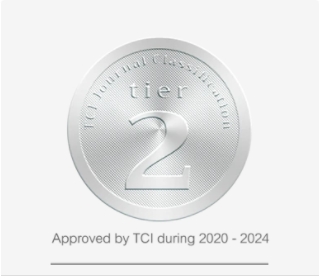ปัจจัยที่มีอิทธิพลต่อพฤติกรรมของผู้ปกครองในการให้ยาปฏิชีวนะ แก่เด็กวัยเรียน
คำสำคัญ:
ยาปฏิชีวนะ, เด็กวัยเรียน, พฤติกรรมการให้ยาปฏิชีวนะ, ผู้ปกครองบทคัดย่อ
การวิจัยครั้งนี้ มีวัตถุประสงค์เพื่อศึกษาปัจจัยที่มี
อิทธิพลต่อพฤติกรรมของผู้ปกครองในการให้ยาปฏิชีวนะ
แก่เด็ก กลุ่มตัวอย่าง คือ ผู้ปกครองที่ดูแลเด็กวัยเรียนและ
อาศัยในเขตเทศบาลเมืองบางศรีเมือง จังหวัดนนทบุรี ใน
ช่วงเดือนพฤษภาคมถึงเดือนกันยายน พ.ศ. 2560 จำนวน
200 ราย เครื่องมือวิจัยประกอบด้วย แบบบันทึกข้อมูล
ส่วนบุคคลของผู้ปกครองและเด็กวัยเรียน แบบสอบถาม
ความรู้เกี่ยวกับการใช้ยาปฏิชีวนะสำหรับเด็ก แบบสอบถาม
อิทธิพลของสิ่งแวดล้อมต่อพฤติกรรมการให้ยาปฏิชีวนะ
แก่เด็ก และแบบสอบถามพฤติกรรมการให้ยาปฏิชีวนะแก่เด็ก
ได้ค่าความตรงของเนื้อหา (IOC) เท่ากับ .75-1, .60-1
และ .60-1 ตามลำดับ ค่าความเที่ยงด้วยวิธีคูเดอร์ริชาร์ดสัน
ของแบบสอบถามความรู้เกี่ยวกับการใช้ยาปฏิชีวนะสำหรับ
เด็กเท่ากับ .77 และสัมประสิทธิ์แอลฟาของครอนบาค
ของแบบสอบถามอิทธิพลของสิ่งแวดล้อมต่อพฤติกรรม
การให้ยาปฏิชีวนะแก่เด็กและพฤติกรรมการให้ยาปฏิชีวนะ
แก่เด็ก เท่ากับ .75 และ .83 ตามลำดับ วิเคราะห์ข้อมูล
ด้วยสถิติพรรณนา สัมประสิทธิ์สหสัมพันธ์ของเพียร์สัน และ
การวิเคราะห์การถดถอยพหุคูณ
ผลการวิจัย พบว่า อายุของเด็กและอิทธิพลของ
สิ่งแวดล้อมสามารถร่วมกันทำนายพฤติกรรมการให้ยา
ปฏิชีวนะแก่เด็กของผู้ปกครองได้ ร้อยละ 15.4 (R2 = .154,
F
(2,197)
= 17.90, p < .001) โดยอิทธิพลของสิ่งแวดล้อม
เป็นปัจจัยที่มีอิทธิพลต่อพฤติกรรมของผู้ปกครองในการให้
ยาปฏิชีวนะแก่เด็กวัยเรียนมากที่สุด (β = .35, t = 5.28,
p < .001)
ผลการวิจัยครั้งนี้แสดงให้เห็นว่า อิทธิพลของ
สิ่งแวดล้อมเป็นปัจจัยสำคัญต่อพฤติกรรมของผู้ปกครอง
ในการให้ยาปฏิชีวนะแก่เด็ก ดังนั้น ผู้บริหารและบุคลากร
ด้านสาธารณสุขควรหาแนวทางในการจัดการสภาพแวดล้อม
ให้ส่งเสริมพฤติกรรมของผู้ปกครองในการให้ยาปฏิชีวนะ
แก่เด็กอย่างถูกต้อง
References
Cantarero-Arevalo, L., Hallas, M. P., & Kaae, S. (2017). Parental knowledge of antibiotic use in children with respiratory infections: a systematic review. International Journal of Pharmacy Practice, 25(1), 31-49.
Chanvatik, S., Lekagul, A., Vongmongkol, V., Patcharanarumol, W., Thunyahan, A., &
Tangcharoensathien, V. (2018). Situation on antimicrobial use and knowledge on antimicrobials: A national health and welfare survey in Thailand 2017. Journal of Health Systems Research, 12(3), 420-436.
Chongtrakul, P. (2011). Rational drug use initiative and implementation (3thed.). Bangkok: Graphic and design publication. (in Thai)
Faul, F., Erdfelder, E., Buchner, A., & Lang, A.-G. (2009). Statistical power analyses using G*Power 3.1: Tests for correlation and regression analyses. Behavior Research Methods, 41, 1149-1160.
Food and Drug Administration. (2016). Spontaneous reports of adverse drug reaction 2015 (pp. 8 and 11-12), Bangkok: Graphic and design publisher. (In Thai)
Khamsarn, S., Nampoonsak, Y., Busamaro, S., Tangkoskul, T., Seenama, C., Rattanaumpawan, P.,
. . . & Thamlikitkul, V. (2016). Epidemiology of antibiotic use and antimicrobial resistance
in selected communities in Thailand. Journal of the Medical Association of Thailand, 99(3), 270-275.
O’Neill., J. (2014). Antimicrobial resistance: Ttackling a crisis for the health and wealth of
nations. Review on antimicrobial resistance. Retrieved from https://amr-review.org /sites/default/files/AMR%20Review%20Paper%20-%20Tackling%20a%20crisis% 20for% 20the%20health%20and%20wealth%20of%20nations_1.pdf
Panagakou, S. G., Papaevangelou, V., Chadjipanayis, A., Syrogiannopoulos, G. A., Theodoridou, M., & Hadjichristodoulou, C. S. (2012). Risk factors of antibiotic misuse for upper respiratory tract infections in children: results from a cross-sectional knowledge-attitude-practice study in Greece. ISRN Pediatrics, 2012, 685302.
Phumart, P., Phodha, T., Thamlikitkul, V., Riewpaiboon, A., Prakongsai, P., & Limwattananon,
S. (2012). Health and economic impacts of antimicrobial resistant infections in Thailand : A preliminary study. Journal of Health Systems Research, 6(3), 352-360. (In Thai)
Porisutiwutiporn, S. & Hemchayat, M. (2014). Influencing factors of antibiotics use behavior of
clients in Khlung hospital, Chantaburi, The Journal of Prapokklao Hospital Clinical
Medical Education, 31(2), 114-127. (in Thai)
Rattanapibun, K., Kongsaktrakul, C., & Patoomwan, A. (2011). Parent participation in the care of hospitalized children. Ramathibodi Nursing Journal, 17(2), 232-247. (in Thai)
Sapsang, S., Phrompittayarat, W., Jariya, W., & Nimpitakpong, P. (2016). The effect of the
innovation of data providing combined with pictogram for antibiotic dry syrup utilization towards the understanding of parents having children with upper respiratory tract infection disease in Kongkrailas hospital, Kongrailas district, Sukhothai province. Proceedings of the national and international graduate research conference 2016 on January 15, 2016 at Pote Sarasin Building, Khon Kaen University, 587-593. (In Thai)
Saidum., S, & Pratheepawanit., N. (2009). Behavior and understanding of parents about dry
syrup antibiotic use. Thai Journal of Hospital Pharmacy, 19(suppl): S79-S89. (In Thai)
Sookphaiboon, S., Apinandacha, C., & Chaisiri, K. (2016). Antibiotics use behavior of patients
in Srangsoke, Ban Mo district. Saraburi province. Proceedings of the 3rd National Conference and Research Presentation “Toward the second decade: sustainability knowledgement on research integration” in June 17, 2016 at Nakhonratchasima College. Mueang Nakhonratchasima District, Nakhonratchasima Province. (In Thai)
Thailand’s National Strategic Plan on Antimicrobial Resistance 2017-2021. Retrieve August 21, 2018 from http://www.fda.moph.go.th/sites/drug/Shared%20Documents/AMR/04. pdf. (In Thai)
Togoobaatar, G., Ikeda, N., Ali, M., Sonomjamts, M., Dashdemberel, S., Mori, R., & Shibuya, K. (2010). Survey of non-prescribed use of antibiotics for children in an urban community in Mongolia. Bulletin of the World Health Organization, 88(12), 930-936.
Ventola, C. L. (2015). The antibiotic resistance crisis: Part 1: Causes and threats. Pharmacy and
Therapeutics, 40(4), 277–283.
Yanti, N. (2017). Factors associated to antibiotic practice among public health students in a
University, Phathum Thani. Humanities and Social Science, 7(2): 57-66.
Youngster, I., Avorn, J., Belleudi, V., Cantarutti, A., Diez-Domingo, J., Kirchmayer, U., . . . Kim, S.
C. (2017). Antibiotic use in children - A aross-national analysis of 6 countries. Journal of Pediatrics, 182, 239-244 e231.
Yu, M., Zhao, G., Stalsby Lundborg, C., Zhu, Y., Zhao, Q., & Xu, B. (2014). Knowledge, attitudes, and practices of parents in rural China on the use of antibiotics in children: a cross-sectional study. BMC Infectious Diseases, 14, 112.





